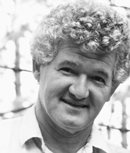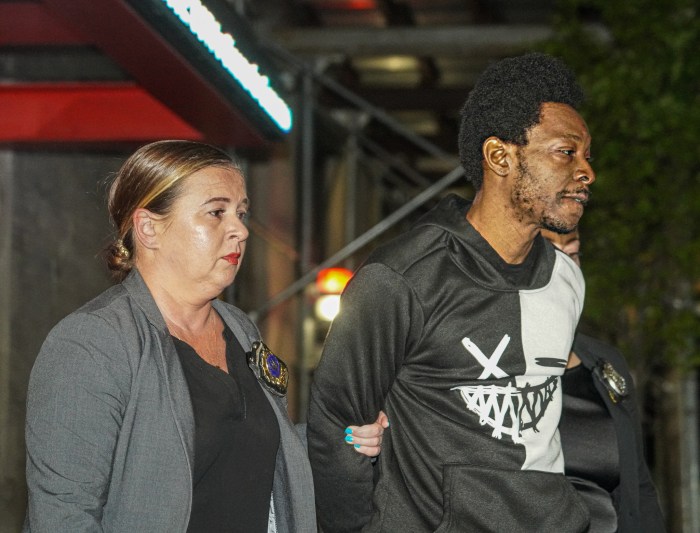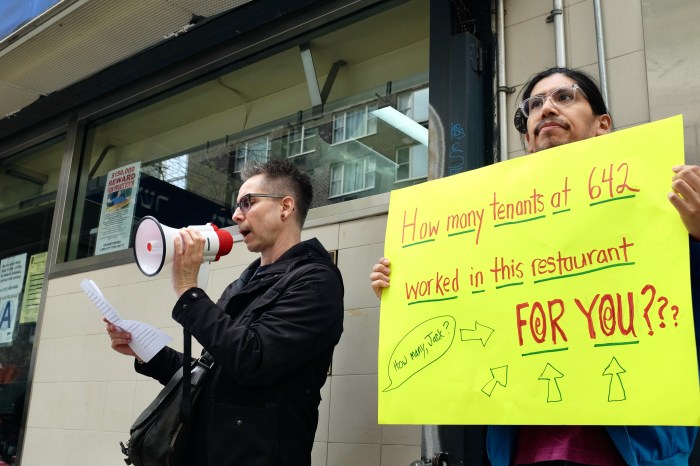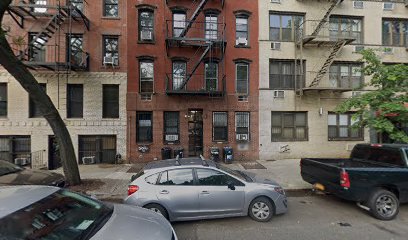By Bonnie Rosenstock
Forty-six years after the plaque commemorating the site of Peter Stuyvesant’s befallen pear tree was repositioned on the northeast corner of Third Ave. and E. 10th St., said plaque will be going home to its rightful owner and original site at the northeast corner of Third Ave. and E. 13th St. In negotiations with William Van Winkle, president of the Holland Society, Charles “Duke” Schlesinger, president of Bendiner & Schlesinger — the medical laboratory at 47-53 Third Ave./101 E. 10th St. — and current plaque owner, has agreed to relinquish the historic 115-year-old bronze tablet. Van Winkle will give it to Philip Clough, president of Kiehl’s Pharmacy. Kiehl’s had been trying for decades to get back the plaque, which had been affixed to its corner wall for 68 years beginning in 1890.
“Philip Clough is very excited,” said James Van Buren, trustee emeritus of the Holland Society, in a phone interview. “He has offered to pay for its removal and clean up. He will see to it that it’s put in a good location. The owner of the [E. 13th St.] condo is also very excited about getting it back.” Clough did not return phone calls. (The condo’s unofficial address, imprinted on an oval plaque at the entranceway, is “203 Pear Tree Place.”)
The saga begins in 1664 when the unpopular Governor Stuyvesant was recalled to Holland after losing New Amsterdam to the British. Stuyvesant returned to the renamed New York in 1667 with a flowering pear tree, which he planted on the northeast corner of Third Ave. and E. 13th St., then part of his sprawling 62-acre Great Bouwerie estate. The dour Dutchman, who chose to live out his days in his beloved former colony, planted the tree as his own memorial “by which my name may be remembered,” the plaque reads. The venerable pear tree, at one time considered “the oldest living thing in the city of New York,” according to Harper’s Monthly Magazine of 1862, succumbed to a one-two punch of bad weather and worse driving in February 1867. After a massive winter storm, which had weakened the tree, two drays (low flat carts without sides or with very low sides, used for heavy loads, especially by brewers) collided, one of which was thrown against the tree with sufficient force to send the 200-year-old veteran to the equivalent of its knees. The tree bore fruit right to the end. With its demise went one of old New York’s popular sightseeing attractions and perhaps the last living vestige of the Dutch presence in the city. The tree was taken down, but a Stuyvesant descendant gave a cross-section of its trunk to The New-York Historical Society, where it is enclosed in a glass case on the fourth floor.
In order to preserve the memory of the Dutch presence, the Holland Society “very quietly” went about town “marking out the old landmarks and sites of buildings long swept away connected with the early history of New-York City,” reported the New York Times on Sept. 30, 1890. (New hyphen York is the original spelling for the Big Apple.) One of the eight earmarked sites was the corner where Stuyvesant’s pear tree reigned. The original corner pharmacy, known as “The Pear Tree Drugstore,” became Kiehl’s in 1851. The plaque, valued at about $300 at the time, hung on the wall until 1958, when Kiehl’s had to move one building farther north because the building it occupied had fallen into disrepair and was slated to be razed. The Holland Society removed the plaque and gave it to St. Mark’s Church in the Bouwerie, site of Stuyvesant’s original chapel and his family’s vault, for safekeeping.
Fast forward to an article in the Times, dated May 15, 1980. At that time, neither the Times nor the Holland Society could recall why, how and when the plaque was placed on Bendiner & Schlesinger’s wall. In the article, Aaron Morse, then owner of Kiehl’s, threatened to sue to get it back. Schlesinger stood fast even though he knew it was in the wrong place, because his father, Charles J. Schlesinger, who died in 197l, “collected Stuyvesant memorabilia and cared about the neighborhood,” he stated in the article.
The trustees of the Holland Society tried to maintain a less litigious position. “The board met and agreed that if the building was ever renovated, they would see to it that it wound up back on the building,” said Van Buren. “We asked for the plaque back two or three times, but Mr. Schlesinger was reluctant to give it up, ‘because it would upset his mother,’ he told us. We gave up. None of us wanted to take legal action.”
Here in The Villager the mystery of the misplaced plaque is revealed at last. Schlesinger gave this reporter a copy of a letter, dated Jan. 29, 1959, in which his father asks the Reverend William J.F. Lydecker, priest in charge of St. Mark’s during an interim period between rectors (January to September 1959), for permission to install the plaque on his building. Apparently, Lydecker agreed.
The letter reads in part, “St. Mark’s is so well known and contains so many things of historical interest that the Plaque may be lost amongst all the other mementos. It is within your province to decide whether or not we are ‘too late,’ but we would deem it a great privilege if you could see your way clear to permit this Plaque to be installed on our building . . . where it would be seen by so many passers-by, now that the neighborhood is improving with the Elevated down and many new apartments going up.”
Two converging events have brought conciliation and closure to this squabble. The first is that Kiehl’s expanded back into the northeast corner in August 2003, replacing Centosette restaurant when its 10-year lease expired and was not renewed. In November 2003, Kiehl’s hosted a grand pear tree planting ceremony and rededication of “Pear Tree Corner.” Many municipal dignitaries attended, as well as Jami Morse Heidegger, granddaughter of Kiehl’s founder Irving Morse, who flew in from California. (Kiehl’s was bought by L’Oréal in 2000.) A modest metal tablet, propped up on the low railing around the pear tree, relates its history.
The other happenstance is that Bendiner & Schlesinger, a neighborhood fixture since 1843, plans to demolish its headquarters and put up a new six-story rental apartment building, with commercial street-level businesses in its place. Schlesinger already moved the laboratory facilities to the Brooklyn Army Terminal in January of this year. However, the lab will continue to service walk-in patients for blood workup, urinalysis, drug screening and the like at a new location that is currently being constructed on E. 13th St. between Second and Third Aves. — within eyeshot of Kiehl’s. Sometime in the near future the weatherworn plaque will be removed.
But for all the hullabaloo over the plaque’s errant location, there have been upsides too. Van Buren acknowledges that Schlesinger pere’s actions may well have saved the plaque from being lost in St. Mark’s archival sinkhole. And it generated a blooming frenzy. “We started putting in flowering pear trees on 10th and Stuyvesant Sts. at least 30 years ago, maybe longer, when we were paying $65 per tree for them,” says Marilyn Appleberg, president of the Tenth & Stuyvesant Sts. Block Association, and proud owner of a lithograph of the pear tree on 13th St. “We were one of the first streets to have them. Now they are ubiquitous. They became the darling of every developer who put them around every new building that went up in the city because of their flowers. The majority of the trees on these two blocks are flowering pear trees. That’s why 10th St. between Second and Third Aves. is considered such a beautiful street. The plaque was the inspiration.”
No doubt there will be a re-rededication of Pear Tree Corner with the spruced up plaque sometime in the future.


















